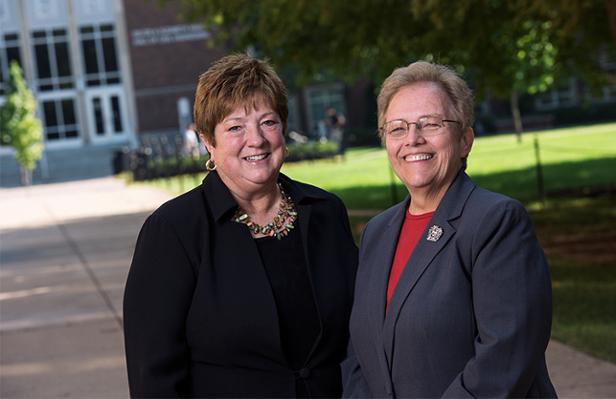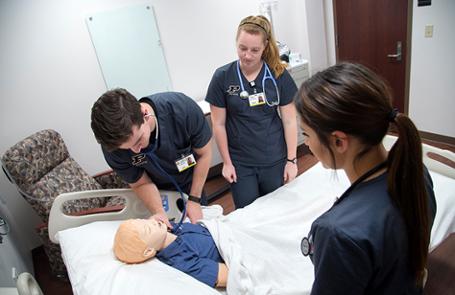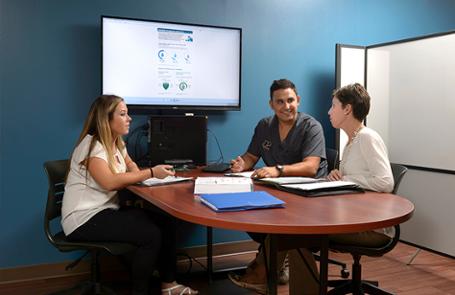Jane Kirkpatrick and Pamela Aaltonen retire from the School of Nursing
Written by By Stephanie Mouw
Two of the School of Nursing’s most esteemed faculty members, Jane Kirkpatrick and Pamela Aaltonen, have retired as head and associate head, respectively. Both have returned as emeritae faculty this fall to facilitate a transition to new leadership in 2018. With a combined 74 years serving the school, Kirkpatrick and Aaltonen’s impact on the program will continue for generations to come.
Transforming the School of Nursing
“Jane and Pam are quite simply the ‘dream team’ of Nursing leadership,” says Christine Ladisch, dean of the College of Health and Human Sciences. “Under their tutelage, the Purdue School of Nursing has grown in reputation, size and scope. It is well-prepared for the next stage of academic maturity — a PhD program, research and external grants. All of this is testimony to the dedication, perseverance and skill of its leaders. I am exceedingly grateful for the privilege and the honor of working with them.”
In the many years that they have been on Purdue’s faculty, Aaltonen and Kirkpatrick have seen the School of Nursing through several transformations. During their time on campus, undergraduate education has shifted from a baccalaureate completion program to a four-year baccalaureate nursing degree program and the addition of an accelerated second-degree bachelor of science. Now the school is making the bold move of doubling the size of the undergraduate student population, which is accompanied by a significant expansion of faculty and staff numbers.
Another change was the addition of graduate programs, which both individuals agree has moved the school in the direction of peer institutions.
“When I started, we had only an undergraduate program,” Aaltonen says. “We now have a full complement of graduate programs, and we just launched the PhD program this year.”
Kirkpatrick adds that the impact of the graduate programs has enhanced the overall scholarship of the faculty and students at all program levels, while maintaining the teaching and community engagement strengths of the nursing program.
“We’re different from most of our Big Ten counterparts in that we’re not located within an academic health sciences center,” Kirkpatrick says. “Because of that, our work is incredibly relevant to the community health care delivery system. At Purdue, we tend to take a broader view of interprofessional collaboration; for example, we have an industrial engineer on our faculty who has contributed to our excellence in integrating systems thinking and quality improvement.”
This interdisciplinary approach is essential, and something at which Purdue excels, Aaltonen says.
“People have to work together in the real world, so encouraging students from different disciplines to collaborate before they launch their professional careers just makes sense,” she says. “It allows for collaborative problem-solving and spurs new approaches to delivery of care, which students can experience and subsequently apply to their careers.”
Kirkpatrick adds, “The grand challenges of health care will not be solved by a single profession acting alone. Bringing together the strengths of multiple professions creates a more comprehensive approach. Learning to conduct and eventually lead transdisciplinary research is a defining feature of our PhD program.”
Not all of the school’s evolutions have occurred within the confines of campus. In addition to the Nursing Center for Family Health, a vital advocate for wellness on campus, Aaltonen and Kirkpatrick have witnessed the launch of family health clinics in two adjacent counties that provide nurse-led primary health care services to residents. In 2009, the clinics became federally qualified health centers and have since doubled in number.
The partnership between Purdue Nursing and the North Central Nursing Clinics is being recognized for excellence this year by Sigma Theta Tau International, an honor society for nursing. Kirkpatrick and Aaltonen have been part of the team that has successfully applied for grant funding for the clinics through the U.S. Department of Health and Human Services Health Resources and Service Administration.
“The growth and expansion of the clinics is a wonderful example of how Purdue’s land-grant mission works,” Kirkpatrick says. “We have an expertise we’re able to share. We’re not only filling a gap, but we’re also providing exquisite learning experiences for Purdue students in nursing, pharmacy, engineering and public health. In addition, engaging Purdue students with our rural population, and in some cases inspiring them to choose a practice location in rural and underserved areas, will ultimately improve access to care for residents in these settings.”
Becoming a part of the College of Health and Human Sciences (HHS) opened the door for a Purdue HHS Extension presence in the School of Nursing. The addition of a health and wellness specialist to the staff has launched new grants and innovative programming. For example, Nursing faculty contributed expertise to the “Be Heart Smart” display at the Indiana State Fair, Kirkpatrick says.
“Collaborations among faculty and Extension staff continue to grow each year and this unique collaboration between Nursing and Extension is receiving notice across the country,” she says.
A Future of Possibilities and Growth
For the future of the program, both Aaltonen and Kirkpatrick are confident the school will continue to evolve and graduate highly qualified nursing students, incorporating new resources along the way. Current technology within the school, like the high-fidelity simulators, already allows students to practice giving care to patients in a controlled environment, and Aaltonen and Kirkpatrick expect it to expand.
“I believe virtual reality — being able to design precisely what people can experience — will totally revolutionize nursing education, giving every student the opportunity to see and learn,” Aaltonen says. “I think it’ll happen soon. I never would’ve dreamt that 20 years ago.”
Once the current undergraduate program expansion is complete, Aaltonen believes the focus will shift to expanding the graduate programs. Both individuals see the school’s previous success in expansion, the broad buy-in from the rest of Purdue University, its continual accreditation, and recent national and international recognition of excellence as factors that provide an excellent foundation for continued growth in new areas.
“The school’s engagement with the community via our nurse-led clinics, connections with practice partners and linkages with Purdue’s HHS Extension will continue to expand,” Kirkpatrick says. “Continued maturation of our programs of research will be important as well. There are so many opportunities to leverage the strengths of the College of Health and Human Sciences and the entire University to address global challenges related to health and health care delivery. This will be increasingly important in the coming years.”
Decades of Purdue Experience
Kirkpatrick, who was formerly associate professor of nursing and associate dean of the College of Health and Human Sciences, started teaching at Purdue in 1981. Her specialization is in obstetrics and neonatal intensive care, as well as integrating technology to better support nursing education.
She is a Fellow in the National League for Nursing Academy of Nursing Education and has received awards from Sigma Theta Tau International for computer-based instructional materials she co-developed. She also is listed in the Purdue Book of Great Teachers, and is a member of the university Teaching Academy.
Aaltonen, who also served as associate professor of nursing, became a public health faculty member at Purdue in 1979. A Charles B. Murphy Outstanding Undergraduate Teaching Award recipient, Aaltonen also has been named in Purdue’s Book of Great Teachers. From natural disaster preparedness to influenza pandemics, Aaltonen is focused on strengthening interdisciplinary approaches to disaster planning and responses.
Aaltonen has served as president of the Indiana Public Health Association and the Great Lakes Coalition of Associations and was elected chairperson of the board of the American Public Health Association. In 2015, she became the first non-physician to receive the Tony & Mary Hulman Lifetime Achievement Award for Distinguished Service from the Indiana Public Health Foundation. The National Association of Local Boards of Health recognized her for her contribution to local public health and she is a recipient of the Indianapolis Star’s Salute to Nurses Community Outreach Award.
Aaltonen also is currently a faculty advisor to Mortar Board, a senior honor society focused on enhancing leadership skills of students across campus. In addition, both Aaltonen and Kirkpatrick served as honorary members of the Iron Key, which selects members who “are to be people of high ideals, with outstanding quality of character, ability, prominence, influence, and who have sincere interest in the affairs and students of Purdue.”
Leaving a Legacy
One thing is for sure — neither Aaltonen nor Kirkpatrick is planning to have a typical retirement. As emeritae faculty, both will continue to contribute to the success of the school.
In November of this year, Aaltonen was elected as president of the American Public Health Association for a three-year term.
She also may continue to collaborate with the Navajo Nation where she has taken students for clinical experiences for over 20 years, though she acknowledges the countless other directions in which this new season of life could take her.
“The opportunity to grow has really kept me at Purdue. I never recall feeling bored in terms of what I’m doing, and there are always new challenges in the way you teach,” she says. “I never would’ve guessed I would have been here this long, and I’m sometimes shocked at how quickly the years went by.”
Kirkpatrick will serve as interim head and associate dean while a national search is underway for her replacement. She is thrilled to continue to promote Purdue nurses and the school.
“We have a school that is making a significant impact on our state and national workforce,” she says. “Our faculty are poised to expand our research enterprise to further impact the profession, health care delivery and the health of the nation. The Purdue tradition of excellence is visible in our alumni and permeates our strong community partnerships. It has been the privilege of my career to serve as the leader of this school.”



